Employee Motivation: Key Factors Influencing Job Role Experiences
VerifiedAdded on 2023/06/12
|7
|1950
|150
Report
AI Summary
This report examines the various factors that influence employee motivation, including financial benefits, work culture, job security, personal growth opportunities, social recognition, leadership support, and organizational vision. It also discusses how specific job roles can impact employee experiences, highlighting positive aspects such as responsibility and empowerment, as well as negative aspects like conflicts, extended working hours, and poor working conditions. The report concludes that understanding and addressing these factors is crucial for improving productivity and retaining employees, emphasizing the importance of creating a supportive and motivating work environment. Desklib provides comprehensive resources including solved assignments and past papers to help students further explore these concepts.
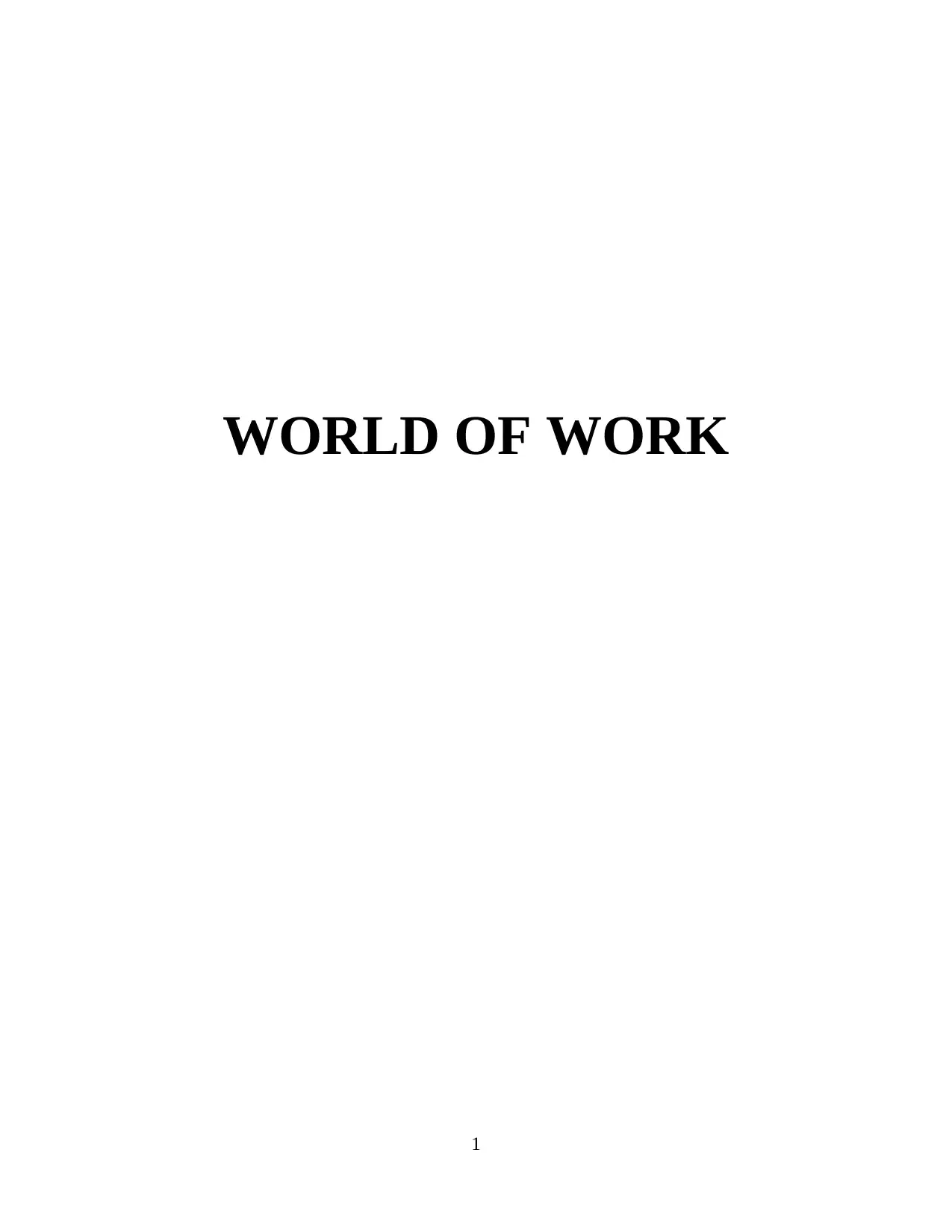
WORLD OF WORK
1
1
Paraphrase This Document
Need a fresh take? Get an instant paraphrase of this document with our AI Paraphraser
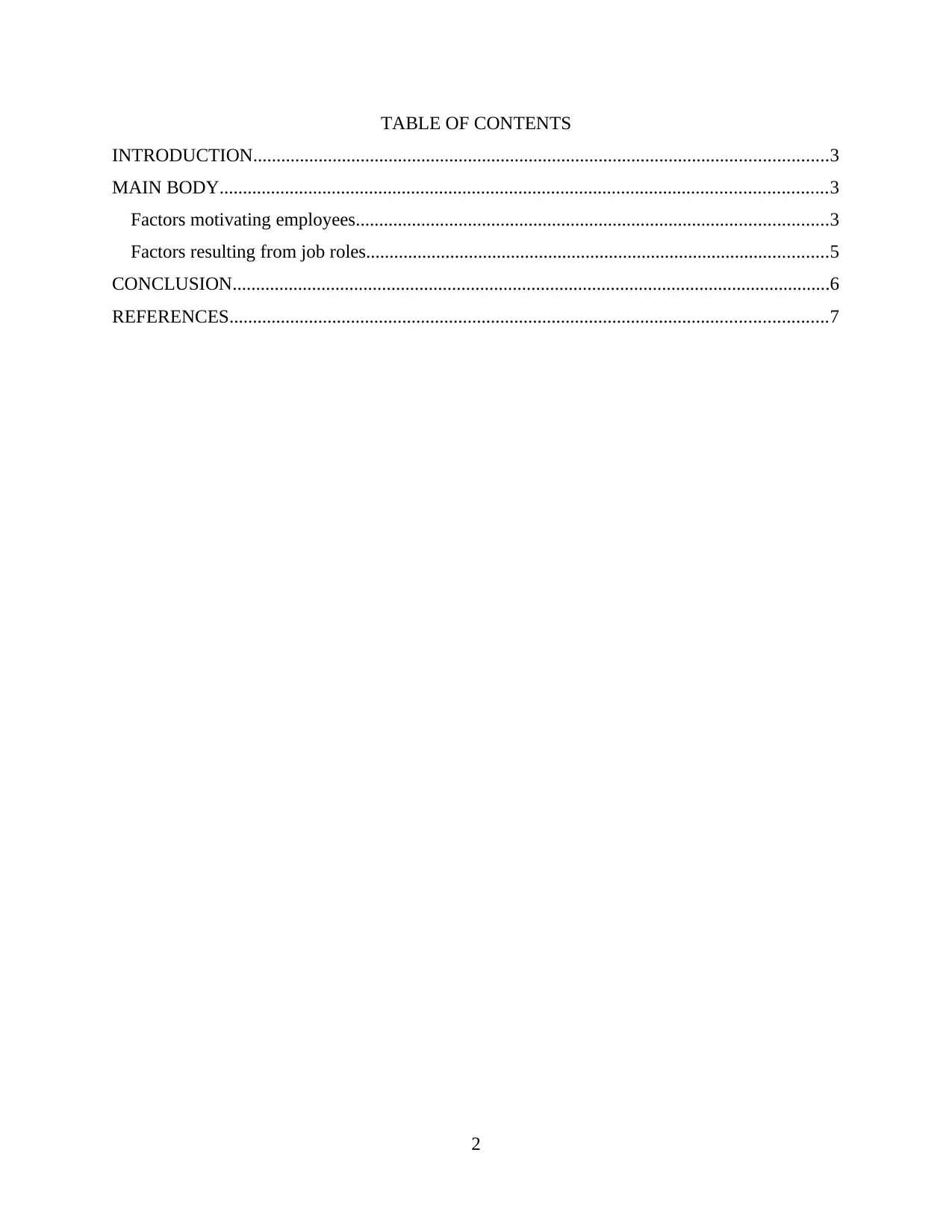
TABLE OF CONTENTS
INTRODUCTION...........................................................................................................................3
MAIN BODY..................................................................................................................................3
Factors motivating employees.....................................................................................................3
Factors resulting from job roles...................................................................................................5
CONCLUSION................................................................................................................................6
REFERENCES................................................................................................................................7
2
INTRODUCTION...........................................................................................................................3
MAIN BODY..................................................................................................................................3
Factors motivating employees.....................................................................................................3
Factors resulting from job roles...................................................................................................5
CONCLUSION................................................................................................................................6
REFERENCES................................................................................................................................7
2
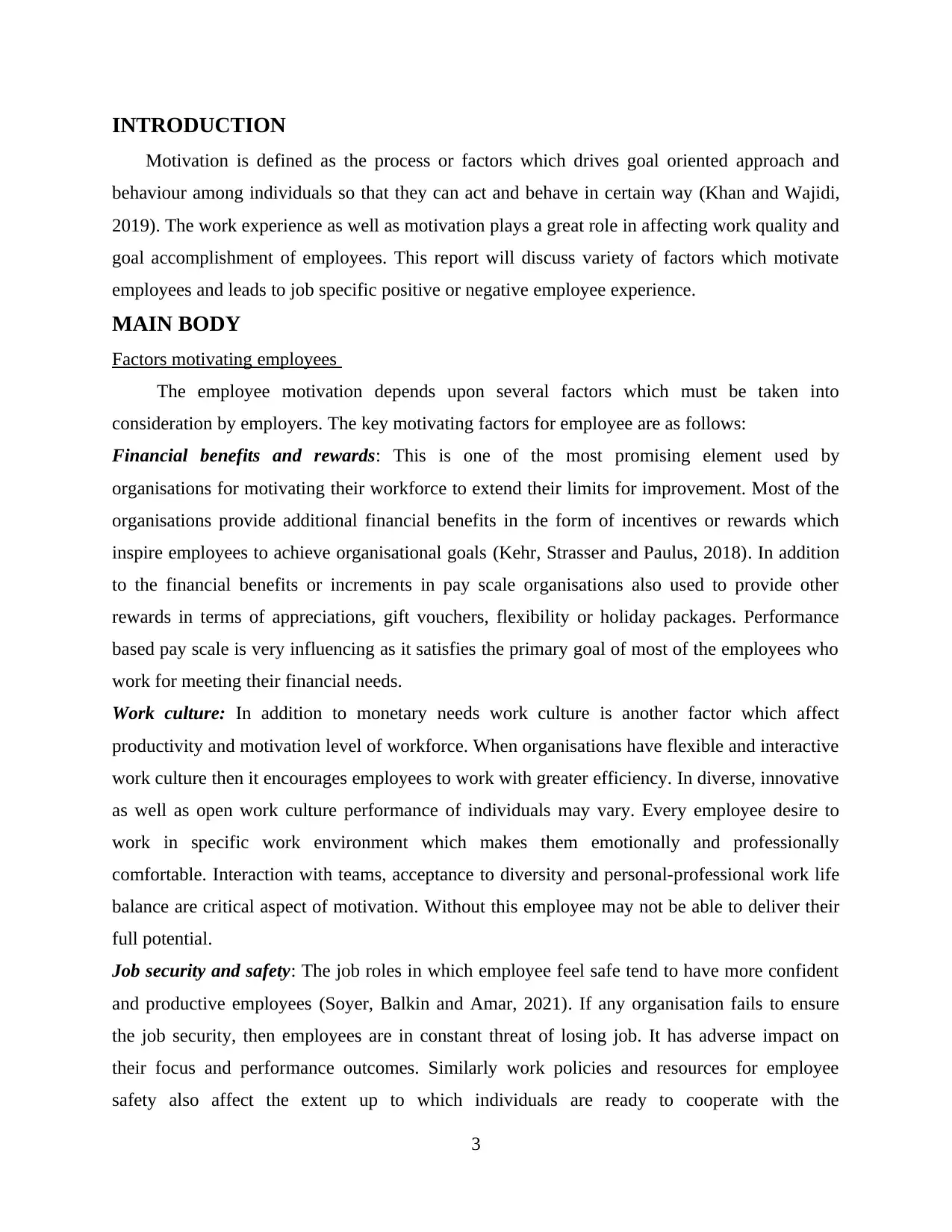
INTRODUCTION
Motivation is defined as the process or factors which drives goal oriented approach and
behaviour among individuals so that they can act and behave in certain way (Khan and Wajidi,
2019). The work experience as well as motivation plays a great role in affecting work quality and
goal accomplishment of employees. This report will discuss variety of factors which motivate
employees and leads to job specific positive or negative employee experience.
MAIN BODY
Factors motivating employees
The employee motivation depends upon several factors which must be taken into
consideration by employers. The key motivating factors for employee are as follows:
Financial benefits and rewards: This is one of the most promising element used by
organisations for motivating their workforce to extend their limits for improvement. Most of the
organisations provide additional financial benefits in the form of incentives or rewards which
inspire employees to achieve organisational goals (Kehr, Strasser and Paulus, 2018). In addition
to the financial benefits or increments in pay scale organisations also used to provide other
rewards in terms of appreciations, gift vouchers, flexibility or holiday packages. Performance
based pay scale is very influencing as it satisfies the primary goal of most of the employees who
work for meeting their financial needs.
Work culture: In addition to monetary needs work culture is another factor which affect
productivity and motivation level of workforce. When organisations have flexible and interactive
work culture then it encourages employees to work with greater efficiency. In diverse, innovative
as well as open work culture performance of individuals may vary. Every employee desire to
work in specific work environment which makes them emotionally and professionally
comfortable. Interaction with teams, acceptance to diversity and personal-professional work life
balance are critical aspect of motivation. Without this employee may not be able to deliver their
full potential.
Job security and safety: The job roles in which employee feel safe tend to have more confident
and productive employees (Soyer, Balkin and Amar, 2021). If any organisation fails to ensure
the job security, then employees are in constant threat of losing job. It has adverse impact on
their focus and performance outcomes. Similarly work policies and resources for employee
safety also affect the extent up to which individuals are ready to cooperate with the
3
Motivation is defined as the process or factors which drives goal oriented approach and
behaviour among individuals so that they can act and behave in certain way (Khan and Wajidi,
2019). The work experience as well as motivation plays a great role in affecting work quality and
goal accomplishment of employees. This report will discuss variety of factors which motivate
employees and leads to job specific positive or negative employee experience.
MAIN BODY
Factors motivating employees
The employee motivation depends upon several factors which must be taken into
consideration by employers. The key motivating factors for employee are as follows:
Financial benefits and rewards: This is one of the most promising element used by
organisations for motivating their workforce to extend their limits for improvement. Most of the
organisations provide additional financial benefits in the form of incentives or rewards which
inspire employees to achieve organisational goals (Kehr, Strasser and Paulus, 2018). In addition
to the financial benefits or increments in pay scale organisations also used to provide other
rewards in terms of appreciations, gift vouchers, flexibility or holiday packages. Performance
based pay scale is very influencing as it satisfies the primary goal of most of the employees who
work for meeting their financial needs.
Work culture: In addition to monetary needs work culture is another factor which affect
productivity and motivation level of workforce. When organisations have flexible and interactive
work culture then it encourages employees to work with greater efficiency. In diverse, innovative
as well as open work culture performance of individuals may vary. Every employee desire to
work in specific work environment which makes them emotionally and professionally
comfortable. Interaction with teams, acceptance to diversity and personal-professional work life
balance are critical aspect of motivation. Without this employee may not be able to deliver their
full potential.
Job security and safety: The job roles in which employee feel safe tend to have more confident
and productive employees (Soyer, Balkin and Amar, 2021). If any organisation fails to ensure
the job security, then employees are in constant threat of losing job. It has adverse impact on
their focus and performance outcomes. Similarly work policies and resources for employee
safety also affect the extent up to which individuals are ready to cooperate with the
3
⊘ This is a preview!⊘
Do you want full access?
Subscribe today to unlock all pages.

Trusted by 1+ million students worldwide
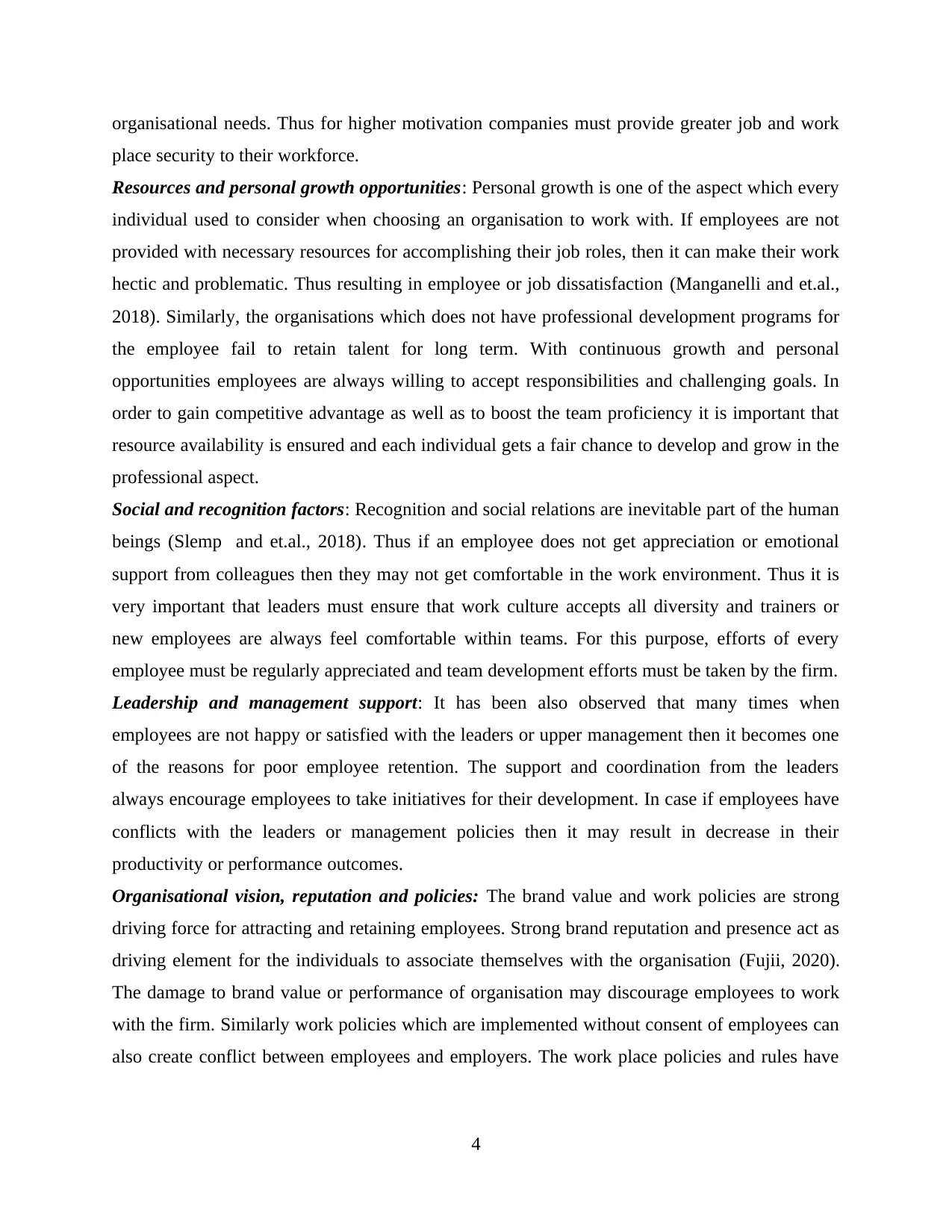
organisational needs. Thus for higher motivation companies must provide greater job and work
place security to their workforce.
Resources and personal growth opportunities: Personal growth is one of the aspect which every
individual used to consider when choosing an organisation to work with. If employees are not
provided with necessary resources for accomplishing their job roles, then it can make their work
hectic and problematic. Thus resulting in employee or job dissatisfaction (Manganelli and et.al.,
2018). Similarly, the organisations which does not have professional development programs for
the employee fail to retain talent for long term. With continuous growth and personal
opportunities employees are always willing to accept responsibilities and challenging goals. In
order to gain competitive advantage as well as to boost the team proficiency it is important that
resource availability is ensured and each individual gets a fair chance to develop and grow in the
professional aspect.
Social and recognition factors: Recognition and social relations are inevitable part of the human
beings (Slemp and et.al., 2018). Thus if an employee does not get appreciation or emotional
support from colleagues then they may not get comfortable in the work environment. Thus it is
very important that leaders must ensure that work culture accepts all diversity and trainers or
new employees are always feel comfortable within teams. For this purpose, efforts of every
employee must be regularly appreciated and team development efforts must be taken by the firm.
Leadership and management support: It has been also observed that many times when
employees are not happy or satisfied with the leaders or upper management then it becomes one
of the reasons for poor employee retention. The support and coordination from the leaders
always encourage employees to take initiatives for their development. In case if employees have
conflicts with the leaders or management policies then it may result in decrease in their
productivity or performance outcomes.
Organisational vision, reputation and policies: The brand value and work policies are strong
driving force for attracting and retaining employees. Strong brand reputation and presence act as
driving element for the individuals to associate themselves with the organisation (Fujii, 2020).
The damage to brand value or performance of organisation may discourage employees to work
with the firm. Similarly work policies which are implemented without consent of employees can
also create conflict between employees and employers. The work place policies and rules have
4
place security to their workforce.
Resources and personal growth opportunities: Personal growth is one of the aspect which every
individual used to consider when choosing an organisation to work with. If employees are not
provided with necessary resources for accomplishing their job roles, then it can make their work
hectic and problematic. Thus resulting in employee or job dissatisfaction (Manganelli and et.al.,
2018). Similarly, the organisations which does not have professional development programs for
the employee fail to retain talent for long term. With continuous growth and personal
opportunities employees are always willing to accept responsibilities and challenging goals. In
order to gain competitive advantage as well as to boost the team proficiency it is important that
resource availability is ensured and each individual gets a fair chance to develop and grow in the
professional aspect.
Social and recognition factors: Recognition and social relations are inevitable part of the human
beings (Slemp and et.al., 2018). Thus if an employee does not get appreciation or emotional
support from colleagues then they may not get comfortable in the work environment. Thus it is
very important that leaders must ensure that work culture accepts all diversity and trainers or
new employees are always feel comfortable within teams. For this purpose, efforts of every
employee must be regularly appreciated and team development efforts must be taken by the firm.
Leadership and management support: It has been also observed that many times when
employees are not happy or satisfied with the leaders or upper management then it becomes one
of the reasons for poor employee retention. The support and coordination from the leaders
always encourage employees to take initiatives for their development. In case if employees have
conflicts with the leaders or management policies then it may result in decrease in their
productivity or performance outcomes.
Organisational vision, reputation and policies: The brand value and work policies are strong
driving force for attracting and retaining employees. Strong brand reputation and presence act as
driving element for the individuals to associate themselves with the organisation (Fujii, 2020).
The damage to brand value or performance of organisation may discourage employees to work
with the firm. Similarly work policies which are implemented without consent of employees can
also create conflict between employees and employers. The work place policies and rules have
4
Paraphrase This Document
Need a fresh take? Get an instant paraphrase of this document with our AI Paraphraser
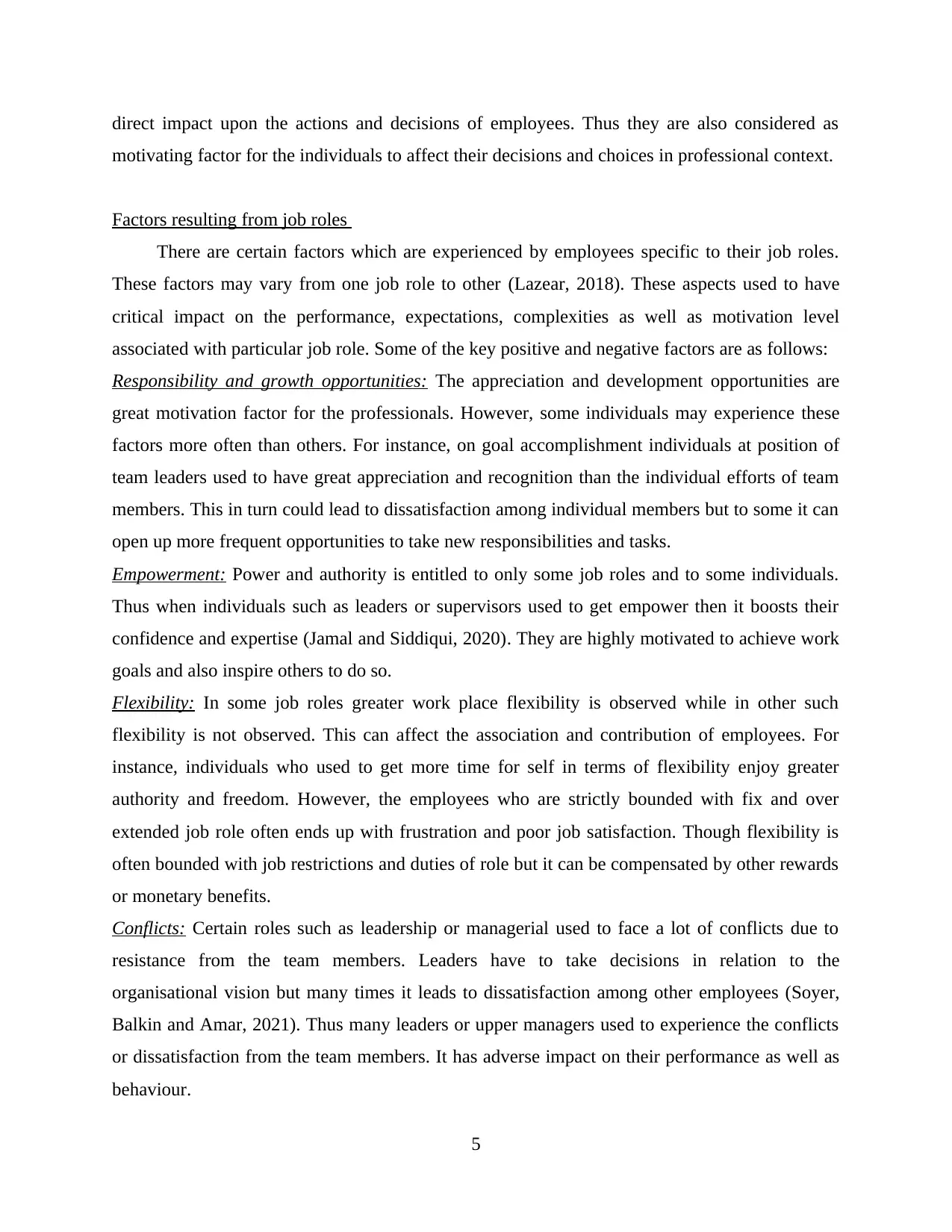
direct impact upon the actions and decisions of employees. Thus they are also considered as
motivating factor for the individuals to affect their decisions and choices in professional context.
Factors resulting from job roles
There are certain factors which are experienced by employees specific to their job roles.
These factors may vary from one job role to other (Lazear, 2018). These aspects used to have
critical impact on the performance, expectations, complexities as well as motivation level
associated with particular job role. Some of the key positive and negative factors are as follows:
Responsibility and growth opportunities: The appreciation and development opportunities are
great motivation factor for the professionals. However, some individuals may experience these
factors more often than others. For instance, on goal accomplishment individuals at position of
team leaders used to have great appreciation and recognition than the individual efforts of team
members. This in turn could lead to dissatisfaction among individual members but to some it can
open up more frequent opportunities to take new responsibilities and tasks.
Empowerment: Power and authority is entitled to only some job roles and to some individuals.
Thus when individuals such as leaders or supervisors used to get empower then it boosts their
confidence and expertise (Jamal and Siddiqui, 2020). They are highly motivated to achieve work
goals and also inspire others to do so.
Flexibility: In some job roles greater work place flexibility is observed while in other such
flexibility is not observed. This can affect the association and contribution of employees. For
instance, individuals who used to get more time for self in terms of flexibility enjoy greater
authority and freedom. However, the employees who are strictly bounded with fix and over
extended job role often ends up with frustration and poor job satisfaction. Though flexibility is
often bounded with job restrictions and duties of role but it can be compensated by other rewards
or monetary benefits.
Conflicts: Certain roles such as leadership or managerial used to face a lot of conflicts due to
resistance from the team members. Leaders have to take decisions in relation to the
organisational vision but many times it leads to dissatisfaction among other employees (Soyer,
Balkin and Amar, 2021). Thus many leaders or upper managers used to experience the conflicts
or dissatisfaction from the team members. It has adverse impact on their performance as well as
behaviour.
5
motivating factor for the individuals to affect their decisions and choices in professional context.
Factors resulting from job roles
There are certain factors which are experienced by employees specific to their job roles.
These factors may vary from one job role to other (Lazear, 2018). These aspects used to have
critical impact on the performance, expectations, complexities as well as motivation level
associated with particular job role. Some of the key positive and negative factors are as follows:
Responsibility and growth opportunities: The appreciation and development opportunities are
great motivation factor for the professionals. However, some individuals may experience these
factors more often than others. For instance, on goal accomplishment individuals at position of
team leaders used to have great appreciation and recognition than the individual efforts of team
members. This in turn could lead to dissatisfaction among individual members but to some it can
open up more frequent opportunities to take new responsibilities and tasks.
Empowerment: Power and authority is entitled to only some job roles and to some individuals.
Thus when individuals such as leaders or supervisors used to get empower then it boosts their
confidence and expertise (Jamal and Siddiqui, 2020). They are highly motivated to achieve work
goals and also inspire others to do so.
Flexibility: In some job roles greater work place flexibility is observed while in other such
flexibility is not observed. This can affect the association and contribution of employees. For
instance, individuals who used to get more time for self in terms of flexibility enjoy greater
authority and freedom. However, the employees who are strictly bounded with fix and over
extended job role often ends up with frustration and poor job satisfaction. Though flexibility is
often bounded with job restrictions and duties of role but it can be compensated by other rewards
or monetary benefits.
Conflicts: Certain roles such as leadership or managerial used to face a lot of conflicts due to
resistance from the team members. Leaders have to take decisions in relation to the
organisational vision but many times it leads to dissatisfaction among other employees (Soyer,
Balkin and Amar, 2021). Thus many leaders or upper managers used to experience the conflicts
or dissatisfaction from the team members. It has adverse impact on their performance as well as
behaviour.
5
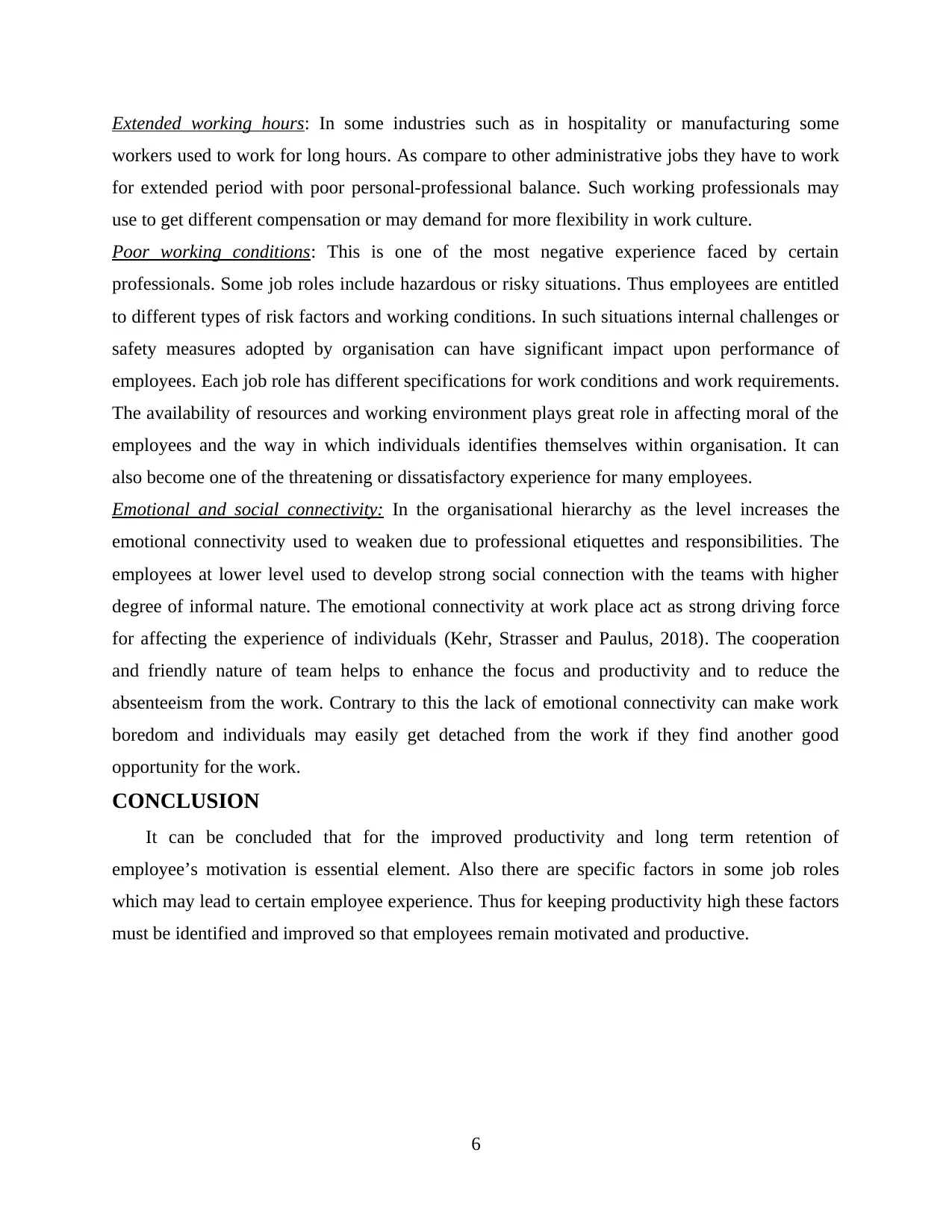
Extended working hours: In some industries such as in hospitality or manufacturing some
workers used to work for long hours. As compare to other administrative jobs they have to work
for extended period with poor personal-professional balance. Such working professionals may
use to get different compensation or may demand for more flexibility in work culture.
Poor working conditions: This is one of the most negative experience faced by certain
professionals. Some job roles include hazardous or risky situations. Thus employees are entitled
to different types of risk factors and working conditions. In such situations internal challenges or
safety measures adopted by organisation can have significant impact upon performance of
employees. Each job role has different specifications for work conditions and work requirements.
The availability of resources and working environment plays great role in affecting moral of the
employees and the way in which individuals identifies themselves within organisation. It can
also become one of the threatening or dissatisfactory experience for many employees.
Emotional and social connectivity: In the organisational hierarchy as the level increases the
emotional connectivity used to weaken due to professional etiquettes and responsibilities. The
employees at lower level used to develop strong social connection with the teams with higher
degree of informal nature. The emotional connectivity at work place act as strong driving force
for affecting the experience of individuals (Kehr, Strasser and Paulus, 2018). The cooperation
and friendly nature of team helps to enhance the focus and productivity and to reduce the
absenteeism from the work. Contrary to this the lack of emotional connectivity can make work
boredom and individuals may easily get detached from the work if they find another good
opportunity for the work.
CONCLUSION
It can be concluded that for the improved productivity and long term retention of
employee’s motivation is essential element. Also there are specific factors in some job roles
which may lead to certain employee experience. Thus for keeping productivity high these factors
must be identified and improved so that employees remain motivated and productive.
6
workers used to work for long hours. As compare to other administrative jobs they have to work
for extended period with poor personal-professional balance. Such working professionals may
use to get different compensation or may demand for more flexibility in work culture.
Poor working conditions: This is one of the most negative experience faced by certain
professionals. Some job roles include hazardous or risky situations. Thus employees are entitled
to different types of risk factors and working conditions. In such situations internal challenges or
safety measures adopted by organisation can have significant impact upon performance of
employees. Each job role has different specifications for work conditions and work requirements.
The availability of resources and working environment plays great role in affecting moral of the
employees and the way in which individuals identifies themselves within organisation. It can
also become one of the threatening or dissatisfactory experience for many employees.
Emotional and social connectivity: In the organisational hierarchy as the level increases the
emotional connectivity used to weaken due to professional etiquettes and responsibilities. The
employees at lower level used to develop strong social connection with the teams with higher
degree of informal nature. The emotional connectivity at work place act as strong driving force
for affecting the experience of individuals (Kehr, Strasser and Paulus, 2018). The cooperation
and friendly nature of team helps to enhance the focus and productivity and to reduce the
absenteeism from the work. Contrary to this the lack of emotional connectivity can make work
boredom and individuals may easily get detached from the work if they find another good
opportunity for the work.
CONCLUSION
It can be concluded that for the improved productivity and long term retention of
employee’s motivation is essential element. Also there are specific factors in some job roles
which may lead to certain employee experience. Thus for keeping productivity high these factors
must be identified and improved so that employees remain motivated and productive.
6
⊘ This is a preview!⊘
Do you want full access?
Subscribe today to unlock all pages.

Trusted by 1+ million students worldwide
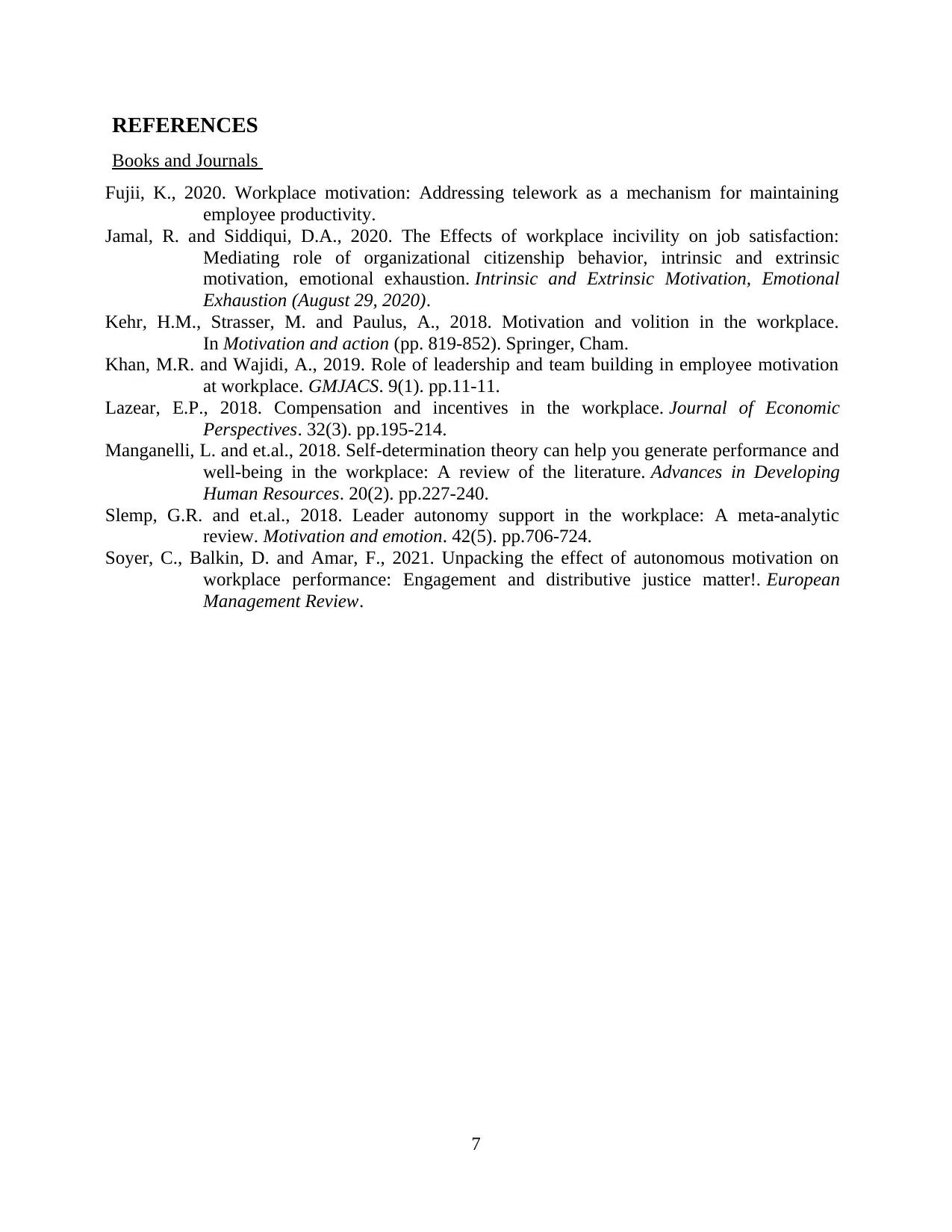
REFERENCES
Books and Journals
Fujii, K., 2020. Workplace motivation: Addressing telework as a mechanism for maintaining
employee productivity.
Jamal, R. and Siddiqui, D.A., 2020. The Effects of workplace incivility on job satisfaction:
Mediating role of organizational citizenship behavior, intrinsic and extrinsic
motivation, emotional exhaustion. Intrinsic and Extrinsic Motivation, Emotional
Exhaustion (August 29, 2020).
Kehr, H.M., Strasser, M. and Paulus, A., 2018. Motivation and volition in the workplace.
In Motivation and action (pp. 819-852). Springer, Cham.
Khan, M.R. and Wajidi, A., 2019. Role of leadership and team building in employee motivation
at workplace. GMJACS. 9(1). pp.11-11.
Lazear, E.P., 2018. Compensation and incentives in the workplace. Journal of Economic
Perspectives. 32(3). pp.195-214.
Manganelli, L. and et.al., 2018. Self-determination theory can help you generate performance and
well-being in the workplace: A review of the literature. Advances in Developing
Human Resources. 20(2). pp.227-240.
Slemp, G.R. and et.al., 2018. Leader autonomy support in the workplace: A meta-analytic
review. Motivation and emotion. 42(5). pp.706-724.
Soyer, C., Balkin, D. and Amar, F., 2021. Unpacking the effect of autonomous motivation on
workplace performance: Engagement and distributive justice matter!. European
Management Review.
7
Books and Journals
Fujii, K., 2020. Workplace motivation: Addressing telework as a mechanism for maintaining
employee productivity.
Jamal, R. and Siddiqui, D.A., 2020. The Effects of workplace incivility on job satisfaction:
Mediating role of organizational citizenship behavior, intrinsic and extrinsic
motivation, emotional exhaustion. Intrinsic and Extrinsic Motivation, Emotional
Exhaustion (August 29, 2020).
Kehr, H.M., Strasser, M. and Paulus, A., 2018. Motivation and volition in the workplace.
In Motivation and action (pp. 819-852). Springer, Cham.
Khan, M.R. and Wajidi, A., 2019. Role of leadership and team building in employee motivation
at workplace. GMJACS. 9(1). pp.11-11.
Lazear, E.P., 2018. Compensation and incentives in the workplace. Journal of Economic
Perspectives. 32(3). pp.195-214.
Manganelli, L. and et.al., 2018. Self-determination theory can help you generate performance and
well-being in the workplace: A review of the literature. Advances in Developing
Human Resources. 20(2). pp.227-240.
Slemp, G.R. and et.al., 2018. Leader autonomy support in the workplace: A meta-analytic
review. Motivation and emotion. 42(5). pp.706-724.
Soyer, C., Balkin, D. and Amar, F., 2021. Unpacking the effect of autonomous motivation on
workplace performance: Engagement and distributive justice matter!. European
Management Review.
7
1 out of 7
Related Documents
Your All-in-One AI-Powered Toolkit for Academic Success.
+13062052269
info@desklib.com
Available 24*7 on WhatsApp / Email
![[object Object]](/_next/static/media/star-bottom.7253800d.svg)
Unlock your academic potential
Copyright © 2020–2025 A2Z Services. All Rights Reserved. Developed and managed by ZUCOL.





